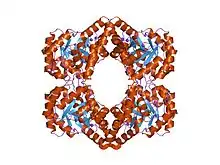Dihydrodipicolinate synthase
4-Hydroxy-tetrahydrodipicolinate synthase (EC 4.3.3.7, dihydrodipicolinate synthase, dihydropicolinate synthetase, dihydrodipicolinic acid synthase, L-aspartate-4-semialdehyde hydro-lyase (adding pyruvate and cyclizing), dapA (gene)) is an enzyme with the systematic name L-aspartate-4-semialdehyde hydro-lyase (adding pyruvate and cyclizing; (4S)-4-hydroxy-2,3,4,5-tetrahydro-(2S)-dipicolinate-forming).[1][2][3][4] This enzyme catalyses the following chemical reaction
- pyruvate + L-aspartate-4-semialdehyde (2S,4S)-4-hydroxy-2,3,4,5-tetrahydrodipicolinate + H2O
| 4-hydroxy-tetrahydrodipicolinate synthase | |||||||||
|---|---|---|---|---|---|---|---|---|---|
| Identifiers | |||||||||
| EC number | 4.3.3.7 | ||||||||
| CAS number | 9055-59-8 | ||||||||
| Databases | |||||||||
| IntEnz | IntEnz view | ||||||||
| BRENDA | BRENDA entry | ||||||||
| ExPASy | NiceZyme view | ||||||||
| KEGG | KEGG entry | ||||||||
| MetaCyc | metabolic pathway | ||||||||
| PRIAM | profile | ||||||||
| PDB structures | RCSB PDB PDBe PDBsum | ||||||||
| Gene Ontology | AmiGO / QuickGO | ||||||||
| |||||||||
| Dihydrodipicolinate synthetase family | |||||||||
|---|---|---|---|---|---|---|---|---|---|
 Crystal structure of dihydrodipicolinate synthase dapa-2 (ba3935) from Bacillus anthracis at 1.94a resolution. | |||||||||
| Identifiers | |||||||||
| Symbol | DHDPS | ||||||||
| Pfam | PF00701 | ||||||||
| Pfam clan | CL0036 | ||||||||
| InterPro | IPR002220 | ||||||||
| PROSITE | PDOC00569 | ||||||||
| SCOP2 | 1dhp / SCOPe / SUPFAM | ||||||||
| CDD | cd00950 | ||||||||
| |||||||||
The reaction proceeds in three consecutive steps.
Function
This enzyme belongs to the family of lyases, specifically the amine-lyases, which cleave carbon-nitrogen bonds. 4-hydroxy-tetrahydrodipicolinate synthase is the key enzyme in lysine biosynthesis via the diaminopimelate pathway of prokaryotes, some phycomycetes, and higher plants. The enzyme catalyses the condensation of L-aspartate-beta-semialdehyde and pyruvate to 4-hydroxy-tetrahydropicolinic acid via a ping-pong mechanism in which pyruvate binds to the enzyme by forming a Schiff base with a lysine residue.[5]
Related enzymes
Three other proteins are structurally related to this enzyme and probably also act via a similar catalytic mechanism. These are Escherichia coli N-acetylneuraminate lyase (EC 4.1.3.3) (protein NanA), which catalyses the condensation of N-acetyl-D-mannosamine and pyruvate to form N-acetylneuraminate; Rhizobium meliloti (Sinorhizobium meliloti) protein MosA,[6] which is involved in the biosynthesis of the rhizopine 3-O-methyl-scyllo-inosamine; and E. coli hypothetical protein YjhH.
Structure
The sequences of 4-hydroxy-tetrahydrodipicolinate synthase from different sources are well-conserved. The structure takes the form of a homotetramer, in which 2 monomers are related by an approximate 2-fold symmetry.[5] Each monomer comprises 2 domains: an 8-fold alpha-/beta-barrel, and a C-terminal alpha-helical domain. The fold resembles that of N-acetylneuraminate lyase. The active site lysine is located in the barrel domain, and has access via 2 channels on the C-terminal side of the barrel.
References
- Yugari Y, Gilvarg C (Dec 1965). "The condensation step in diaminopimelate synthesis". The Journal of Biological Chemistry. 240 (12): 4710–6. PMID 5321309.
- Blickling S, Renner C, Laber B, Pohlenz HD, Holak TA, Huber R (Jan 1997). "Reaction mechanism of Escherichia coli dihydrodipicolinate synthase investigated by X-ray crystallography and NMR spectroscopy". Biochemistry. 36 (1): 24–33. doi:10.1021/bi962272d. PMID 8993314.
- Devenish SR, Blunt JW, Gerrard JA (Jun 2010). "NMR studies uncover alternate substrates for dihydrodipicolinate synthase and suggest that dihydrodipicolinate reductase is also a dehydratase". Journal of Medicinal Chemistry. 53 (12): 4808–12. doi:10.1021/jm100349s. PMID 20503968.
- Soares da Costa TP, Muscroft-Taylor AC, Dobson RC, Devenish SR, Jameson GB, Gerrard JA (Jul 2010). "How essential is the 'essential' active-site lysine in dihydrodipicolinate synthase?". Biochimie. 92 (7): 837–45. doi:10.1016/j.biochi.2010.03.004. PMID 20353808.
- Mirwaldt C, Korndörfer I, Huber R (Feb 1995). "The crystal structure of dihydrodipicolinate synthase from Escherichia coli at 2.5 A resolution". Journal of Molecular Biology. 246 (1): 227–39. doi:10.1006/jmbi.1994.0078. PMID 7853400.
- Murphy PJ, Trenz SP, Grzemski W, De Bruijn FJ, Schell J (Aug 1993). "The Rhizobium meliloti rhizopine mos locus is a mosaic structure facilitating its symbiotic regulation". Journal of Bacteriology. 175 (16): 5193–204. doi:10.1128/jb.175.16.5193-5204.1993. PMC 204987. PMID 8349559.
Further reading
External links
- 4-hydroxy-tetrahydrodipicolinate+synthase at the US National Library of Medicine Medical Subject Headings (MeSH)